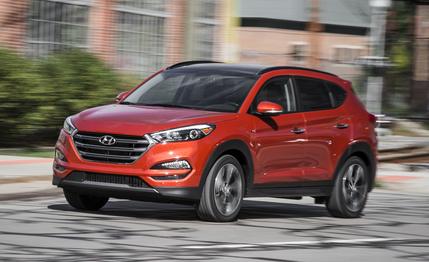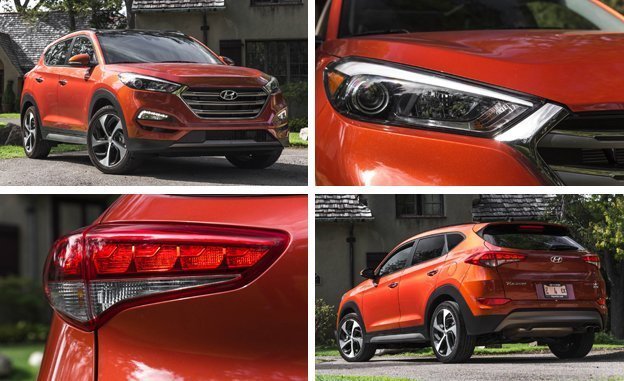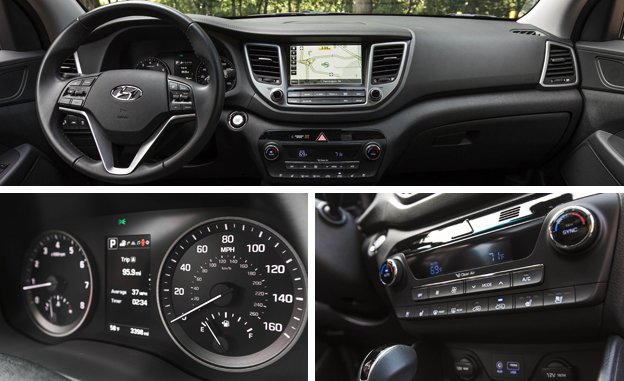 Instrumented Test
Instrumented Test
In the ever-escalating battle for the hearts and checkbooks of North American crossover SUV buyers, Hyundai is drizzling a bit of European character into its all-new 2016 Tucson. A seven-speed dual-clutch automatic transmission, torque-rich four-cylinder turbo, stiff structure, and improved chassis are some of the attributes that give this compact crossover a more composed, more substantial—dare we say almost engaging?—feel behind the wheel. The Continental flavoring is no accident, as the new Tucson is also the replacement for the Euro-market ix35, and so it must not disappoint picky Old World drivers traveling on, say, unrestricted autobahn stretches or serpentine Bavarian two-lanes.

The Tucson’s new 1.6-liter turbo four-cylinder (standard on all but the base SE model and shared with the Sonata Eco) is a model of flexibility and tractability. Its small twin-scroll turbocharger is sized for quick response rather than max output. Here making 175 horsepower, the 1.6-liter’s output is down a tad compared to that of compact crossover competitors such as the Honda CR-V, the Toyota RAV4, the Mazda CX-5 2.5L, and the Ford Escape 1.6L EcoBoost, but Hyundai’s four bests the field with more torque: 195 lb-ft developed earlier in the rev range. There’s almost no lag—the Tucson’s torque curve is mostly a plateau reaching maximum elevation at 1500 rpm and carrying on to 4500 rpm. That means even with part-throttle, it’s easy to get to cruising speed and to exploit open pockets in traffic without the need for wide-open-throttle bursts and heroic downshifts.
Aside from the 1.6-liter turbo, the feature that most distinguishes the Tucson Limited (as well as Eco and Sport trim levels) is the seven-speed dual-clutch automatic transmission. It’s not quite as responsive as the six-speed DCT in some Volkswagens and Audis, but it’s a class standout among compact crossovers using conventional torque-converter automatics or CVTs. When rolling, the DCT feels crisp with deft, torque-managed shifts that you’ll see in the tach more than feel in the butt. Launches from rest are mostly well-mannered, but sometimes uphill starts with sudden throttle applications can result in some brief driveline oscillation and rubber-banding as the DCT’s clutches engage and boost ramps up. We also noticed some uncouth lurching while gently reversing and feathering the throttle.
Overall, the Tucson’s lively feel was borne out in our testing. The Hyundai’s 7.6-second zero-to-60-mph run bested those of competitors we’ve tested, including the Escape 1.6L EcoBoost (9.1 seconds), RAV4 (8.2), CR-V (8.2), and even the CX-5 2.5L (7.7). The Tucson also bested the last Audi Q3 2.0T Quattro to the 60-mph mark (7.8 seconds). Shod with 245/45R-19 tires, the 2016 Tucson Limited didn’t disappoint on the skidpad either, its 0.83 g of grip topping the CR-V Touring (0.76 g), RAV4 XLE (0.78 g), Escape, and CX-5 (both 0.81 g). The Tucson’s 177-foot stop from 70 mph, however, wasn’t top-of-segment but stretched only one foot longer than the Audi Q3 and two feet beyond that of the top-ranked non-luxury compact crossover, the Mazda CX-5.

What the test numbers don’t show is just how solid the Tucson is. It’s the smallest of three crossovers in Hyundai’s lineup (the others being the short-wheelbase, two-row Santa Fe Sport and the three-row regular Santa Fe), yet it feels the most premium. Hyundai claims extensive use of structural adhesives at weld seams, and judging by how stiff and rattle-free the body feels, we have no reason to doubt that. Roll is well controlled, yet the suspension is compliant while providing good wheel control without harshness. Despite column-mounted electric power-steering assist, responses to steering inputs are direct and linear although lacking the more connected feel of a CX-5’s communicative helm.
Inside, the Tucson’s supple leather seats have good torso support, and the switchgear offers a solid, tactile feel and look. The console shift lever is pleasantly substantial, suggesting the mass and inertia of a premium luxury car. Limited trim brings extra padding to the door panels and console. Thoughtful storage solutions abound. An 8.0-inch infotainment touch screen is easy to use and features handy redundant volume and tuning knobs for no-look adjustments on the road. Optional premium content usually reserved for luxury crossovers, such as ventilated front seats, heated rear seats, and automatic emergency braking with pedestrian protection, is available.
It’s ironic that Volkswagen, the only mainstream full-line European brand in the U.S., has dithered and delayed updates to its crossover lineup while diluting the European character of its “Americanized” sedans (the Jetta and the Passat). Meanwhile, Hyundai cranks up the European character and feature content of its Tucson compact crossover in a quest to put it on more shopping lists. And the sales numbers say it’s working.